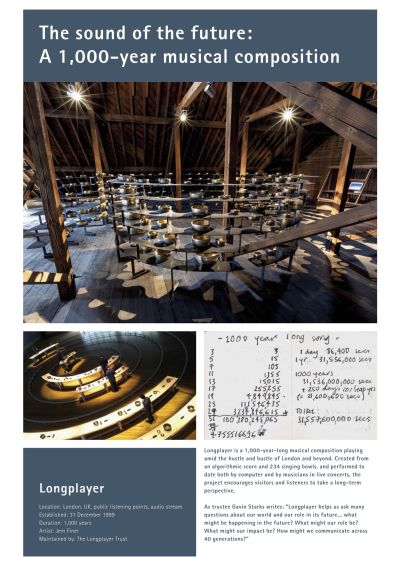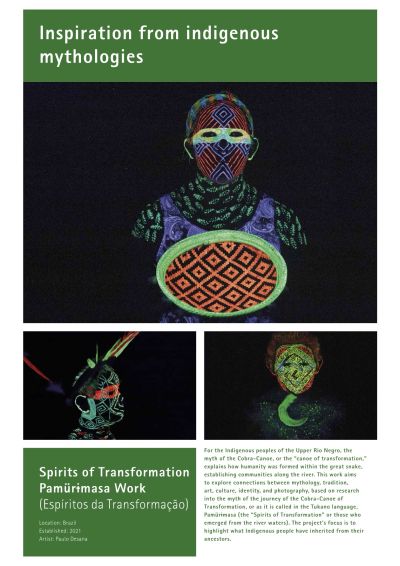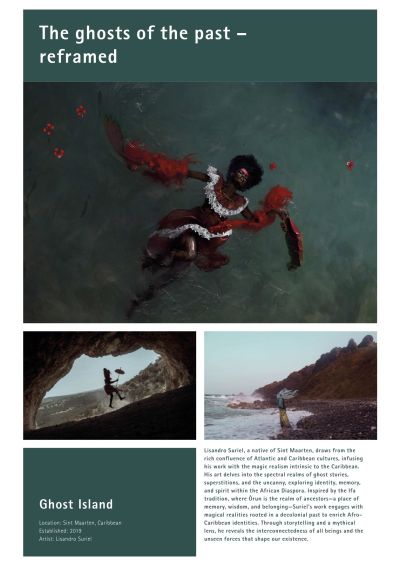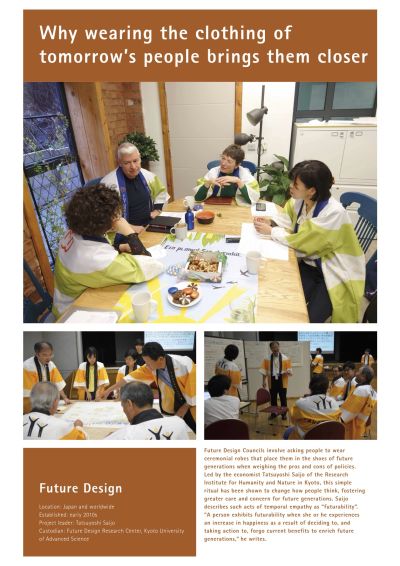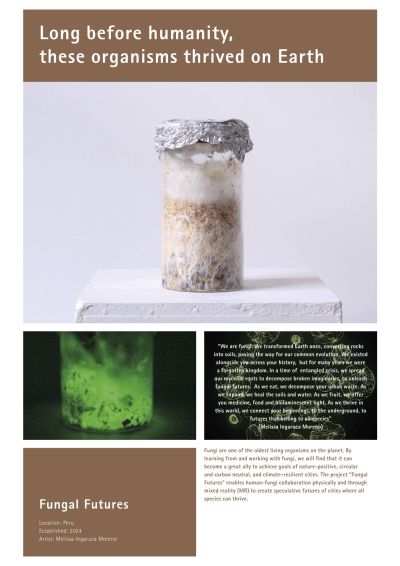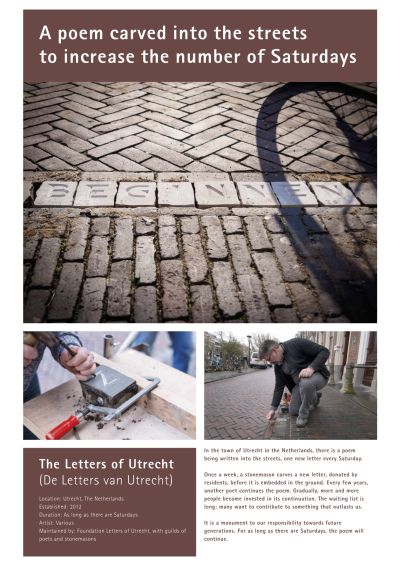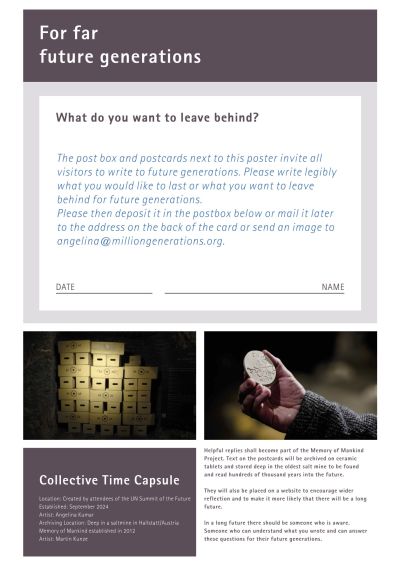Good Ancestors exhibition 2024: Difference between revisions
MGxWikiSysop (talk | contribs) (→Introduction: add text) |
MGxWikiSysop (talk | contribs) (add information from posters and photocredits per poster, part 1) |
||
| Line 1: | Line 1: | ||
= Good Ancestors: Art and Culture for Future Generations = | = Exhibition Good Ancestors: Art and Culture for Future Generations = | ||
Exhibit organised by the Permanent Mission of the Kingdom of the Netherlands to the United Nations and the Permanent Mission of Jamaica to the United Nations, UN General Assembly Building, Visitors Lobby, Gallery C, September 16th through 27th, 2024 | Exhibit organised by the Permanent Mission of the Kingdom of the Netherlands to the United Nations and the Permanent Mission of Jamaica to the United Nations, UN General Assembly Building, Visitors Lobby, Gallery C, September 16th through 27th, 2024 | ||
| Line 6: | Line 6: | ||
== Introduction == | == Introduction == | ||
[[File:Good Ancestors expo UN 1.jpg|400px| | [[File:Good Ancestors expo UN 1.jpg|400px|right]] | ||
In the early 21st Century, short-termism is ubiquitous – and yet the world has never faced so many complex challenges that require a long term perspective to solve. | In the early 21st Century, short-termism is ubiquitous – and yet the world has never faced so many complex challenges that require a long term perspective to solve. | ||
| Line 20: | Line 20: | ||
Through art and culture, we are reminded of our collective responsibility towards future generations, cultivating the awareness and frameworks needed to safeguard their rights. By embracing the idea of our far-distant descendants, we find a unifying force, one that transcends division and inspires collaboration. Safeguarding future generations may be humanity's most powerful legacy and the key to our collective existence. | Through art and culture, we are reminded of our collective responsibility towards future generations, cultivating the awareness and frameworks needed to safeguard their rights. By embracing the idea of our far-distant descendants, we find a unifying force, one that transcends division and inspires collaboration. Safeguarding future generations may be humanity's most powerful legacy and the key to our collective existence. | ||
=== Organisers === | |||
Organised by the Permanent Mission of the Kingdom of the Netherlands to the United Nations and the Permanent Mission of Jamaica to the United Nations, 2024 | |||
=== Photo Credits === | |||
* Cave of the Hands: 1. © Pablo Gimenez; 2. CC BY-SA 3.0 by Fjturban; 3. CC-BY-SA 2.0 Carlos Alberto Zito | |||
* Ancestors Dreaming: Laurielle Noel © Ainsley Burrows (3x) | |||
* Future Library: 1+2. Kristin von Hirsch; 3. Einar Aslaksen all © Katie Patterson Studios | |||
* Great African Art Banner: 1+3. © Emmanuel Motta/GAAB; 2. © Collin Isimbwa / GAAB | |||
* Time Pyramid 1+2. © Felix Schmitt; 3. © Oliver Waimann | |||
* Uffington Horse: © Peter Landers (3x) | |||
* Clock of the Long Now: Chris Baldwin & Jesse Chandler © The Long Now Foundation (3x) | |||
* Fishermen and the Ocean: © Subodh Kerkar (3x) | |||
* Longplayer: 1. © James Whitaker; 2+3. © Jem Finer | |||
* Spirits of Transformation: © Paulo Desana (3x) | |||
* Cage Project: © John Cage Organ Foundation (3x) | |||
* Ghost Island: © Lisandro Suriel (3x) | |||
* Future Design: 1. © Reiichiro Ishii; 2+3. © Tatsuyoshi Saijo, Yahaba FDWS | |||
* Fungal Futures: 1+2. © Melissa Ingaruca Moreno; 3. © Kira Koch / Melissa Ingaruca Moreno | |||
* De Letters van Utrecht: 1+2. © Dick Sijtsma; 3. © Ramses Singeling - Pergamijn | |||
* Collective Time Capsule: 1. © Angelina Kumar & Hanneke Verheijke; 2+3. © Martin Kunze | |||
=== Contributors, who helped prepare the exhibition === | |||
Alexandra Helfrich, Burbank, CA, USA; Alimi Salifou, Lagos, Nigeria (Partnership for Future Generations in Africa, Intergenerational Center for Global Action); Anastasia Evgrafova, Kazakhstan; Anneli Borgmann, Halberstadt, Germany (Cage Project); Angelina Kumar, artist from Delhi, India; Anne Beate Hovind, Oslo, Norway (Future Library); Barbara Laber, Munich, Germany (Zeitpyramide); Christopher Daniel, London, UK (Polysemic, Long Now London); Claire Marshall, Sydney, Australia (Museum of Futures); Claudette Salinas Leyva, Mexico, Mexico (SOIF); Danielle Engelman, San Francisco, USA (Long Now Foundation); Erlijn Mulder, Utrecht, The Netherlands (Letters of Utrecht); Julia Paes Leme, Rio de Janeiro, Brasil (Museu do Amanhã/ IDG); Georg Weckwerth, Vienna, Austria; Hanneke Verheijke, Utrecht, The Netherlands (Letters of Utrecht); Jacob Ellis, Cardiff, Wales; Jem Finer, London, UK (Longplayer); Lisa Russell, Mombasa, Kenya; Lorna Okeng, Kampala, Uganda, Art Advisor and Curator of the Great African Arts Banner; Lukas Pfaller, Dresden, Germany (Zeitpyramide); Lydia Caldana, São Paulo, Brazil (Future Resources); Mallory Profeta, Utrecht, The Netherlands (Long-term Art Projects); Marina Piquet, Rio de Janeiro, Brasil (Museu do Amanhã/IDG); Masako Ichihara, Kyoto, Japan (Future Design); Mehdi Nemri, Djerba, Tunisia; Melissa Ingaruca Moreno, Lima, Peru (Natura, Mycohakers Berlin); Michael Münker, Utrecht, The Netherlands (milliongenerations.org); Muhammad Dauda, Nigeria; Nathan Leonard, Tanzania; Rainer O. Neugebauer, Halberstadt,Germany (Cage Project); Ruben van Gogh, Utrecht, The Netherlands (Letters of Utrecht); Richard Fisher, London, UK (author ‘The Long View’); Tatsuyoshi Saijo, Kyoto, Japan (Future Design); Umar Sheraz, Islamabad, Pakistan (COMSATS University); Vidya Kandadai Giridharan, Vienna, Austria; Werner Waimann, Wemding, Germany (Zeitpyramide) | |||
== Join hands with deep-time ancestors == | == Join hands with deep-time ancestors == | ||
[[File:Good Ancestors expo UN 2.jpg|400px| | [[File:Good Ancestors expo UN 2.jpg|400px|right]] | ||
Cave of the Hands (Cueva de las Manos) | |||
* Location: Santa Cruz, Argentina | |||
* Established: ca. 7300 BCE (earliest prints) | |||
* Artists: unknown | |||
* UNESCO World Heritage Site | |||
Many of the imprints of hands in the Cueva de los Manos in Argentina are almost 10,000 years old. | |||
The strikingly modern handwave links humans across time. By imagining a man, woman or child placing their hand on the same rock surface many thousands of years ago, this ancient artwork bridges the gap between now and then, inviting people to reflect on the long-lived cultural heirlooms we have inherited – and the legacies we all leave behind. | |||
[https://en.wikipedia.org/wiki/Cueva_de_las_Manos more information] | [https://en.wikipedia.org/wiki/Cueva_de_las_Manos more information] | ||
Photo Credits | |||
* 1. © [https://pabloagimenez.wixsite.com/professional Pablo Gimenez] | |||
* 2. CC BY-SA 3.0 by [https://commons.wikimedia.org/wiki/File:Cuevamanos3399.jpg Fjturban] | |||
* 3. CC-BY-SA 2.0 [https://commons.m.wikimedia.org/wiki/User:Buen_amigo Carlos Alberto Zito] | |||
== New Mythologies == | == New Mythologies == | ||
[[File:Good Ancestors expo UN 3.jpg|400px|none]] | [[File:Good Ancestors expo UN 3.jpg|400px|none]] | ||
[https://www.ainsleyburrowsart.com/ | |||
Ancestors Dreaming | |||
* Location: Jamaica | |||
* Established: 2023 | |||
* Artist: [[https://www.ainsleyburrowsart.com/ Ainsley Burrows] | |||
The practice of artist Ainsley Burrows is deeply rooted in themes of Afro-Futurism – a way of looking at the future and alternate realities through a Black cultural lens – as well as the exploration of the future of dreaming. | |||
His paintings often feature abstract figures depicted in disjointed movements, suggesting multiple perspectives and moments in time. The sharp lines within his compositions create a sense of confinement, yet certain elements break free from the constraints, resulting in refracted visual echoes and a simultaneous disruption of time and space. | |||
== Books that can't be read until the next century == | == Books that can't be read until the next century == | ||
[[File:Good Ancestors expo UN 4.jpg|400px|none]] | [[File:Good Ancestors expo UN 4.jpg|400px|none]] | ||
[https://www.futurelibrary.no/ Future Library | Future Library | ||
* Location: Oslo, Norway | |||
* Established: 2014 | |||
* Duration: 100 years | |||
* Artist: [https://katiepaterson.org/ Katie Paterson] | |||
* Maintained by: [https://www.futurelibrary.no/ Future Library Trust] | |||
== The largest African art piece ever made == | == The largest African art piece ever made == | ||
[[File:Good Ancestors expo UN 5.jpg|400px|none]] | [[File:Good Ancestors expo UN 5.jpg|400px|none]] | ||
The Great African Art Banner | |||
* Location: Uganda (Presence - Pan African) | |||
* Conceptualized 2010; | |||
* Registered 2022 | |||
* Artist: Various (56,000) | |||
* Maintained by: [https://gaabafrica.org/ “Great African Art Banner” Initiative] | |||
Over the next two years, 56,000 artworks representing the 55 African nations and the African diaspora will make a 55km-long physical art collection called the Great African Art Banner. It will be repeated every four years perpetually towards 2063. | |||
The establishment of the first banner will build to the 2026 Great Africa Arts Music and Culture Festival (bringing 56 countries to participate) – the biggest Olympic - like convergence of the arts since 1977’s FESTAC festival in Nigeria. | |||
[https://gaabafrica.org/ GAAB website]] | [https://gaabafrica.org/ GAAB website]] | ||
==The pyramid that will take 1,200 years to build == | ==The pyramid that will take 1,200 years to build == | ||
[[File:Good Ancestors expo UN 6.jpg|400px|none]] | [[File:Good Ancestors expo UN 6.jpg|400px|none]] | ||
Time Pyramid (Zeitpyramide) | |||
* Location: Wemding, Germany | |||
* Established: 1993 | |||
* Duration: 1,200 years | |||
* Artist: Manfred Laber | |||
* Maintained by: [http://www.zeitpyramide.de/ Stiftung Wemdinger Zeitpyramide] | |||
In Bavaria in 1993, Manfred Laber initiated construction of a pyramid of 120 blocks. One added every decade. The project began to commemorate the city’s 1,200th anniversary. Wemding expects to continue building and maintaining the pyramid for another 1,200 years. | |||
Initially, the pyramid was controversial. Today, the town is invested in its construction. There are four blocks so far – the most recent in 2023. Each new placement reminds locals and visitors of the many generations who will follow them. | |||
[https://en.wikipedia.org/wiki/Zeitpyramide more information (English)/][http://www.zeitpyramide.de/ (German)] | [https://en.wikipedia.org/wiki/Zeitpyramide more information (English)/][http://www.zeitpyramide.de/ (German)] | ||
==This ancient horse must be maintained or it will disappear== | ==This ancient horse must be maintained or it will disappear== | ||
[[File:Good Ancestors expo UN 7.jpg|400px|none]] | [[File:Good Ancestors expo UN 7.jpg|400px|none]] | ||
[https://en.wikipedia.org/wiki/Uffington_White_Horse Uffington White Horse] | The White Horse of Uffington | ||
* Location: Oxfordshire, United Kingdom | |||
* Established: ~1,000 BCE | |||
* Artist: Unknown | |||
* Custodians: [https://www.english-heritage.org.uk/ English Heritage]; [https://www.nationaltrust.org.uk/ The National Trust]; [https://longnowlondon.org/ Long Now London] | |||
Dating to the Bronze Age, a horse the size of a football field is carved into the grass of a hill in Southern England. | |||
Left alone, it would be overgrown and disappear within a decade, so it has been maintained for 3,000 years by a process of “rechalking”. Every year, the UK National Trust – and volunteers such as the Long Now London group – attend the site with mallets and buckets of fresh chalk to ensure this ancient artwork continues to exist for future generations to see. It reminds us that long-term cultural legacies often require maintenance – and if we want them to last, we need communities willing to take on that mantle within their lifetimes. | |||
More information: [https://en.wikipedia.org/wiki/Uffington_White_Horse Uffington White Horse] | |||
==A clock designed to keep time for ten millennia == | ==A clock designed to keep time for ten millennia == | ||
[[File:Good Ancestors expo UN 8.jpg|400px|none]] | [[File:Good Ancestors expo UN 8.jpg|400px|none]] | ||
The Clock of the Long Now | |||
* Location: Texas, USA | |||
* Established: 31 December 1999 | |||
* Artist: [https://en.wikipedia.org/wiki/Danny_Hillis Danny Hillis] | |||
* Duration: 10,000 years | |||
* Maintained by: [https://longnow.org/ The Long Now Foundation] | |||
The Clock of the Long Now is an immense mechanical monument, installed in a mountain in Texas, and designed to keep accurate time for 10,000 years. It is hundreds of feet tall, engineered to require minimal maintenance, and powered by mechanical energy harvested from sunlight as well as visitors. The Clock offers an enduring symbol of our personal connection to the distant future. | |||
Ten thousand years is about the age of modern civilization, so The Clock will measure out a future of civilization equal to its past. This assumes our civilization is in the middle | |||
of whatever journey we are on - an implicit statement of optimism. | |||
[https://longnow.org/ Long Now Foundation] | [https://longnow.org/ Long Now Foundation] | ||
== | == Oceanic feeling: sensing the eternal currents of the sea == | ||
[[File:Good Ancestors expo UN 9.jpg|400px|none]] | [[File:Good Ancestors expo UN 9.jpg|400px|none]] | ||
[https://subodhkerkar.com/ | Fishermen and the Ocean | ||
* Location: India | |||
* Established: 2019 | |||
* Duration: Temporary | |||
* Artist: [https://subodhkerkar.com/ Subodh Kerkar] | |||
Subodh Kerkar’s images of Indian fishermen celebrate the long- term role the ocean plays in shaping civilizations. | |||
“I have had the opportunity to know the life of fishermen at close quarters, since I used to practise medicine in a fishing village. The ocean is not just the provider of fish; their existence is marinated in the ocean. Through my works I have tried to present this idea of inseparability. The fishermen become the fish bone. The fishermen become the boat. The fishermen sit in a circle to perform some oceanic ritual. The fishermen sit in two rows touching the soles of their feet to mimic the keel of a boat. The fishermen line up to pay homage to the ocean. They walk along the waves.” – Subodh Kerkar | |||
==The sound of the Future: A 1,000-year musical composition == | ==The sound of the Future: A 1,000-year musical composition == | ||
[[File:Good Ancestors expo UN10.jpg|400px|none]] | [[File:Good Ancestors expo UN10.jpg|400px|none]] | ||
Longplayer | |||
Location: London, UK, public listening points, audio stream Established: 31 December 1999 | |||
Duration: 1,000 years | |||
Artist: [https://en.wikipedia.org/wiki/Jem_Finer Jem Finer] | |||
Maintained by: [[https://longplayer.org/ The Longplayer Trust] | |||
Longplayer is a 1,000-year-long musical composition playing amid the hustle and bustle of London and beyond. Created from an algorithmic score and 234 singing bowls, and performed to date both by computer and by musicians in live concerts, the project encourages visitors and listeners to take a long-term perspective. | |||
As trustee Gavin Starks writes: “Longplayer helps us ask many questions about our world and our role in its future... what might be happening in the future? What might our role be? What might our impact be? How might we communicate across 40 generations?” | |||
[https://longplayer.org/ Longplayer website] | [https://longplayer.org/ Longplayer website] | ||
Revision as of 19:17, 5 October 2024
Exhibition Good Ancestors: Art and Culture for Future Generations
Exhibit organised by the Permanent Mission of the Kingdom of the Netherlands to the United Nations and the Permanent Mission of Jamaica to the United Nations, UN General Assembly Building, Visitors Lobby, Gallery C, September 16th through 27th, 2024
The information below is provided to accompany the exhibition. Some of the content was licensed explicitly for the exhibition and must not be reproduced without prior consent of the respective owners, listed on the first page of the exhibit.
Introduction
In the early 21st Century, short-termism is ubiquitous – and yet the world has never faced so many complex challenges that require a long term perspective to solve.
On current trajectories, the planet we hand over to tomorrow's generations could be in a worse state than the one we inherited. The continued progress, or even existence, of future generations is therefore not ensured. While social, economic and technological advances enable some of us to live longer and better lives, we have also created pathways to existential risks for humanity.
Rooted in indigenous (Haudenosaunee) philosophy, the Seventh Generation Principle emphasizes that decisions made today should be considered in the light of their impact on at least the next seven generations. This intergenerational responsibility must be applied to the decisions we make today. We are dependent on one another to create a peaceful, inclusive, just and sustainable world, not only across borders but also across time.
How can we be good ancestors towards future generations and leave a better world behind than the one we inherited?
The ‘Good Ancestors’ exhibition invites you to journey across time, from the coast of the Indian Subcontinent to the depths of the Amazon, exploring art projects, cultural practices and traditions from across the world, deeply rooted in intergenerational thinking and our shared human experience.
Woven throughout the exhibition are universal themes of community, ritual, and care—guided by the belief that future generations must be central to all our actions today.
Through art and culture, we are reminded of our collective responsibility towards future generations, cultivating the awareness and frameworks needed to safeguard their rights. By embracing the idea of our far-distant descendants, we find a unifying force, one that transcends division and inspires collaboration. Safeguarding future generations may be humanity's most powerful legacy and the key to our collective existence.
Organisers
Organised by the Permanent Mission of the Kingdom of the Netherlands to the United Nations and the Permanent Mission of Jamaica to the United Nations, 2024
Photo Credits
- Cave of the Hands: 1. © Pablo Gimenez; 2. CC BY-SA 3.0 by Fjturban; 3. CC-BY-SA 2.0 Carlos Alberto Zito
- Ancestors Dreaming: Laurielle Noel © Ainsley Burrows (3x)
- Future Library: 1+2. Kristin von Hirsch; 3. Einar Aslaksen all © Katie Patterson Studios
- Great African Art Banner: 1+3. © Emmanuel Motta/GAAB; 2. © Collin Isimbwa / GAAB
- Time Pyramid 1+2. © Felix Schmitt; 3. © Oliver Waimann
- Uffington Horse: © Peter Landers (3x)
- Clock of the Long Now: Chris Baldwin & Jesse Chandler © The Long Now Foundation (3x)
- Fishermen and the Ocean: © Subodh Kerkar (3x)
- Longplayer: 1. © James Whitaker; 2+3. © Jem Finer
- Spirits of Transformation: © Paulo Desana (3x)
- Cage Project: © John Cage Organ Foundation (3x)
- Ghost Island: © Lisandro Suriel (3x)
- Future Design: 1. © Reiichiro Ishii; 2+3. © Tatsuyoshi Saijo, Yahaba FDWS
- Fungal Futures: 1+2. © Melissa Ingaruca Moreno; 3. © Kira Koch / Melissa Ingaruca Moreno
- De Letters van Utrecht: 1+2. © Dick Sijtsma; 3. © Ramses Singeling - Pergamijn
- Collective Time Capsule: 1. © Angelina Kumar & Hanneke Verheijke; 2+3. © Martin Kunze
Contributors, who helped prepare the exhibition
Alexandra Helfrich, Burbank, CA, USA; Alimi Salifou, Lagos, Nigeria (Partnership for Future Generations in Africa, Intergenerational Center for Global Action); Anastasia Evgrafova, Kazakhstan; Anneli Borgmann, Halberstadt, Germany (Cage Project); Angelina Kumar, artist from Delhi, India; Anne Beate Hovind, Oslo, Norway (Future Library); Barbara Laber, Munich, Germany (Zeitpyramide); Christopher Daniel, London, UK (Polysemic, Long Now London); Claire Marshall, Sydney, Australia (Museum of Futures); Claudette Salinas Leyva, Mexico, Mexico (SOIF); Danielle Engelman, San Francisco, USA (Long Now Foundation); Erlijn Mulder, Utrecht, The Netherlands (Letters of Utrecht); Julia Paes Leme, Rio de Janeiro, Brasil (Museu do Amanhã/ IDG); Georg Weckwerth, Vienna, Austria; Hanneke Verheijke, Utrecht, The Netherlands (Letters of Utrecht); Jacob Ellis, Cardiff, Wales; Jem Finer, London, UK (Longplayer); Lisa Russell, Mombasa, Kenya; Lorna Okeng, Kampala, Uganda, Art Advisor and Curator of the Great African Arts Banner; Lukas Pfaller, Dresden, Germany (Zeitpyramide); Lydia Caldana, São Paulo, Brazil (Future Resources); Mallory Profeta, Utrecht, The Netherlands (Long-term Art Projects); Marina Piquet, Rio de Janeiro, Brasil (Museu do Amanhã/IDG); Masako Ichihara, Kyoto, Japan (Future Design); Mehdi Nemri, Djerba, Tunisia; Melissa Ingaruca Moreno, Lima, Peru (Natura, Mycohakers Berlin); Michael Münker, Utrecht, The Netherlands (milliongenerations.org); Muhammad Dauda, Nigeria; Nathan Leonard, Tanzania; Rainer O. Neugebauer, Halberstadt,Germany (Cage Project); Ruben van Gogh, Utrecht, The Netherlands (Letters of Utrecht); Richard Fisher, London, UK (author ‘The Long View’); Tatsuyoshi Saijo, Kyoto, Japan (Future Design); Umar Sheraz, Islamabad, Pakistan (COMSATS University); Vidya Kandadai Giridharan, Vienna, Austria; Werner Waimann, Wemding, Germany (Zeitpyramide)
Join hands with deep-time ancestors
Cave of the Hands (Cueva de las Manos)
- Location: Santa Cruz, Argentina
- Established: ca. 7300 BCE (earliest prints)
- Artists: unknown
- UNESCO World Heritage Site
Many of the imprints of hands in the Cueva de los Manos in Argentina are almost 10,000 years old.
The strikingly modern handwave links humans across time. By imagining a man, woman or child placing their hand on the same rock surface many thousands of years ago, this ancient artwork bridges the gap between now and then, inviting people to reflect on the long-lived cultural heirlooms we have inherited – and the legacies we all leave behind.
Photo Credits
- 1. © Pablo Gimenez
- 2. CC BY-SA 3.0 by Fjturban
- 3. CC-BY-SA 2.0 Carlos Alberto Zito
New Mythologies
Ancestors Dreaming
- Location: Jamaica
- Established: 2023
- Artist: [Ainsley Burrows
The practice of artist Ainsley Burrows is deeply rooted in themes of Afro-Futurism – a way of looking at the future and alternate realities through a Black cultural lens – as well as the exploration of the future of dreaming.
His paintings often feature abstract figures depicted in disjointed movements, suggesting multiple perspectives and moments in time. The sharp lines within his compositions create a sense of confinement, yet certain elements break free from the constraints, resulting in refracted visual echoes and a simultaneous disruption of time and space.
Books that can't be read until the next century
Future Library
- Location: Oslo, Norway
- Established: 2014
- Duration: 100 years
- Artist: Katie Paterson
- Maintained by: Future Library Trust
The largest African art piece ever made
The Great African Art Banner
- Location: Uganda (Presence - Pan African)
- Conceptualized 2010;
- Registered 2022
- Artist: Various (56,000)
- Maintained by: “Great African Art Banner” Initiative
Over the next two years, 56,000 artworks representing the 55 African nations and the African diaspora will make a 55km-long physical art collection called the Great African Art Banner. It will be repeated every four years perpetually towards 2063.
The establishment of the first banner will build to the 2026 Great Africa Arts Music and Culture Festival (bringing 56 countries to participate) – the biggest Olympic - like convergence of the arts since 1977’s FESTAC festival in Nigeria.
The pyramid that will take 1,200 years to build
Time Pyramid (Zeitpyramide)
- Location: Wemding, Germany
- Established: 1993
- Duration: 1,200 years
- Artist: Manfred Laber
- Maintained by: Stiftung Wemdinger Zeitpyramide
In Bavaria in 1993, Manfred Laber initiated construction of a pyramid of 120 blocks. One added every decade. The project began to commemorate the city’s 1,200th anniversary. Wemding expects to continue building and maintaining the pyramid for another 1,200 years.
Initially, the pyramid was controversial. Today, the town is invested in its construction. There are four blocks so far – the most recent in 2023. Each new placement reminds locals and visitors of the many generations who will follow them.
more information (English)/(German)
This ancient horse must be maintained or it will disappear
The White Horse of Uffington
- Location: Oxfordshire, United Kingdom
- Established: ~1,000 BCE
- Artist: Unknown
- Custodians: English Heritage; The National Trust; Long Now London
Dating to the Bronze Age, a horse the size of a football field is carved into the grass of a hill in Southern England.
Left alone, it would be overgrown and disappear within a decade, so it has been maintained for 3,000 years by a process of “rechalking”. Every year, the UK National Trust – and volunteers such as the Long Now London group – attend the site with mallets and buckets of fresh chalk to ensure this ancient artwork continues to exist for future generations to see. It reminds us that long-term cultural legacies often require maintenance – and if we want them to last, we need communities willing to take on that mantle within their lifetimes.
More information: Uffington White Horse
A clock designed to keep time for ten millennia
The Clock of the Long Now
- Location: Texas, USA
- Established: 31 December 1999
- Artist: Danny Hillis
- Duration: 10,000 years
- Maintained by: The Long Now Foundation
The Clock of the Long Now is an immense mechanical monument, installed in a mountain in Texas, and designed to keep accurate time for 10,000 years. It is hundreds of feet tall, engineered to require minimal maintenance, and powered by mechanical energy harvested from sunlight as well as visitors. The Clock offers an enduring symbol of our personal connection to the distant future.
Ten thousand years is about the age of modern civilization, so The Clock will measure out a future of civilization equal to its past. This assumes our civilization is in the middle of whatever journey we are on - an implicit statement of optimism.
Oceanic feeling: sensing the eternal currents of the sea
Fishermen and the Ocean
- Location: India
- Established: 2019
- Duration: Temporary
- Artist: Subodh Kerkar
Subodh Kerkar’s images of Indian fishermen celebrate the long- term role the ocean plays in shaping civilizations.
“I have had the opportunity to know the life of fishermen at close quarters, since I used to practise medicine in a fishing village. The ocean is not just the provider of fish; their existence is marinated in the ocean. Through my works I have tried to present this idea of inseparability. The fishermen become the fish bone. The fishermen become the boat. The fishermen sit in a circle to perform some oceanic ritual. The fishermen sit in two rows touching the soles of their feet to mimic the keel of a boat. The fishermen line up to pay homage to the ocean. They walk along the waves.” – Subodh Kerkar
The sound of the Future: A 1,000-year musical composition
Longplayer Location: London, UK, public listening points, audio stream Established: 31 December 1999 Duration: 1,000 years Artist: Jem Finer Maintained by: [The Longplayer Trust Longplayer is a 1,000-year-long musical composition playing amid the hustle and bustle of London and beyond. Created from an algorithmic score and 234 singing bowls, and performed to date both by computer and by musicians in live concerts, the project encourages visitors and listeners to take a long-term perspective.
As trustee Gavin Starks writes: “Longplayer helps us ask many questions about our world and our role in its future... what might be happening in the future? What might our role be? What might our impact be? How might we communicate across 40 generations?”
Pamurimasa: Spirits of Transformation
Paulo Desana's webpage on indigena.art
The worlds slowest concert
The ghosts of the past - reframed
Artist Lisandro Suriel's website
Future Design
Long before humanity, these organisms thrived on Earth
A poem carved into the streets to increase the number of Saturdays
more information (English)/(Dutch)
For far future generations
Artist Angelina Kumar's website and Martin Kunze's Memory of Mankind









